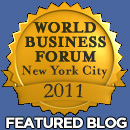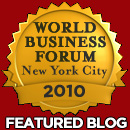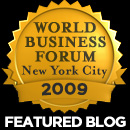May05
Andrea Meyer
Point: When forecasting, keep in mind that simple signs can have a deeper meaning if you take the time to look.
Story: At the Cultivating Intuition: Effective Forecasting in the Face of Rapid Change workshop preceding the World Innovation Forum, forecaster Paul Saffo described how to watch for signs of the future. In 1991, as he and his newlywed bride were driving to Mendocino County for their honeymoon, he saw a new road sign that was so intriguing that he turned around, drove back, and took a photograph of it while his exasperated bride waited. The sign simply said, “End Emergency Call Boxes.” But the sign told Saffo of both the near-term future and the long-term future. First, the literal interpretation of the sign told Saffo that he and his wife were on their own. If they had any problems, they couldn’t expect to quickly reach the authorities for help. Yet fear of being incommunicado was not why Saffo stopped at the sign.
Second, and more crucially, the sign indicated to Saffo that people’s expectations had changed. Why would the California Highway Department think that such as sign was needed? Prior to the 1990s, no one expected to be in constant communication. But now, the advent of the solar-powered call boxes meant that people expected more.
The sign was part of a series of long-term changes in communications. Only a couple of years later, the sign was gone because the call boxes extended all the way to the Canadian border. Low-cost communications enabled almost-universal coverage. About a decade later, the call boxes themselves were gone, because everyone had cell phones. Yet that sign triggered Saffo’s thinking about communications and how changing technology led to changing expectations and future changes in technology.
Action
- Look at signs and signals in the environment. (Paul recommends carrying a camera at all times to snap pictures of these signs)
- Examine the deeper meaning of those signs — what do the signs say about the changing expectations of consumers and citizens?
- Consider how your future products and services can meet those changing expectations
How-to, Innovation
May04
Andrea Meyer
Point: Innovation processes must reflect people’s true behavior
Story:
Dan Ariely, author of Predictably Irrational, finds that people display a host of consistent behavioral quirks in how they respond to products and marketing. These cognitive biases change not only people’s decisions and subjective opinions, but also their objective performance with products.
For example, in his work on behavioral economics, Ariely and his colleagues documented such quirks as:
- how “free” items can bias decisions
- how arbitrary numbers (e.g., the last two digits of your social security number) can affect the price a person is willing to pay
- how adding a choice that almost no one will choose can cause many people pick the more-expensive choice
- how publicly-made choices differ from privately-made choices.
Note: Dan Ariely will be speaking about the hidden forces that shape people’s decisions at the World Innovation Forum in New York City on May 6, 2009 at 4-5:30 pm.
One strong example from Ariely’s research is the effect of product price on performance. Does getting a good deal on a product change how well that product works? To test this, Ariely and his colleagues studied the efficacy of products such as pain killers, cold medicine, and energy drinks as a function of the price people pay from them. In the energy drink study, people bought an energy drink (some test subjects got a price discount), drank the drink, and then performed a word puzzle test. People who paid more for the drink solved more of the puzzles than did people who got a discount for the identical drink. Similar patterns appeared in the pain killer study and cold medicine research.
The implication for innovation: This research helps explain why good products can fail because of the discrepancies between beliefs in how people should act versus how they actually do act. Moreover, this irrational behavior is consistent across people, products, and time. Because the irrational behavior is consistent, companies can adjust their innovation, product development, product testing, and marketing processes to fit people’s real behaviors.
Action:
- Understand the human biases that affect product choice, willingness to pay, and product performance.
- Design products that suit how people are, not how people should be.
- Create product testing processes (e.g., focus groups and lead user studies) that replicate or control for the effects of actual retail and usage scenarios
How-to, Innovation, New Product Development, Strategy
Apr27
Andrea Meyer
Point: You don’t have to be the originator of an idea to succeed with it.
Story: Sam Walton didn’t invent discount retailing. Instead, he learned of the idea from an article about two Ben Franklin stores in Minnesota trying self-service. At the time, self-service retail was a brand new concept. Previously, customers came to a counter and the full-service clerks helped the customer by picking items from the shelves behind the counter. Upon reading the article about this new concept, Sam went to investigate. “I rode the bus all night long to two little towns up there — Pipestone and Worthingon,” Walton recounts in his autobiography. “They had shelves on the side and two island counters all the way back. No clerks with cash registers around the store. Just checkout registers up front. I liked that. So I did that, too,” In 1950, Walton’s Five and Dime was the third self-service variety store in the country.
But Sam didn’t simply imitate this one discount retailing idea. He continued to toy & tinker with it and improve it, even as it grew and became successful. He kept his stores well stocked with lots of items, stayed open late, bought goods in bulk to reduce costs, and pioneered communications and logistics technologies to maintain his everyday low price strategy. “As good as business was, I never could leave well enough alone, and, in fact, I think my constant fiddling and meddling with the status quo may have been one of my biggest contributions to the later success of Wal-Mart.”
Howard Gardner, Professor of Cognition and Education at the Harvard Graduate School of Education, sees this style of constant innovation as key characteristic of creative people. He says, it’s not a flash-in-the-pan, one-time-only thing. it’s a whole style of existence. People who are creative are always thinking about the domains in which they work. They’re always tinkering. They’re always saying, “what makes sense here, what doesn’t make sense? And if it doesn’t make sense, can I do something about it?”
Action:
- Be open to the new and different — seek out odd-ball business practices in out-of-the-way places
- Study how others do what they do, why they do it, and how it can work in your situation
- Adopt and adapt those discovered ideas and keep tweaking the ideas
For more information: Sam Walton: Made In America and Creative Spirit by Daniel Goleman, Paul Kaufman, and Michael Ray.
Case study, Creativity, How-to, Innovation, Strategy










